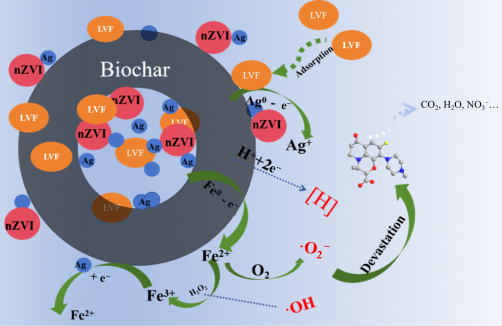Science
Researchers Develop Innovative System to Remove Antibiotics from Wastewater

Researchers from Suzhou University of Science and Technology and Beijing Technology and Business University, among others, have unveiled a groundbreaking study focused on enhancing wastewater treatment technologies. The research, titled “Dual-functional Ag-Fe@Biochar systems: simultaneous adsorption and radical-mediated oxidation of antibiotics in Fenton-like reactions,” was published in the journal Frontiers of Environmental Science & Engineering.
The study addresses the growing ecological concerns linked to the widespread use of Levofloxacin (LVF), a third-generation fluoroquinolone antibiotic utilized in human, veterinary, and agricultural applications. LVF’s prevalence raises significant risks, including the potential development of drug-resistant bacteria and “superbugs.” Traditional wastewater treatment methods, particularly classical Fenton processes, often struggle with limitations such as narrow pH adaptation ranges and inherent drawbacks, making effective LVF removal a pressing challenge.
To tackle this issue, the researchers developed a silver-modified nano zero-valent iron loaded coconut shell biochar composite, referred to as Ag-nZVI/BC. The synthesis involved a two-step method, allowing for a comprehensive investigation into the composite’s structural characteristics, performance in LVF removal, influencing factors, degradation mechanisms, and the associated ecotoxicity.
Key Findings and Implications
The findings from this research are notable. The Ag-nZVI/BC composite demonstrated a specific surface area of 785.4345 m2/g, featuring abundant oxygen-containing functional groups that enhance its effectiveness in adsorption. Under optimal conditions—specifically, a pH of 3.0, 10 mmol/L H2O2, and a catalyst concentration of 0.3 g/L—the system achieved an impressive 91.2% removal rate of LVF within just 60 minutes.
Further analysis revealed that hydroxyl radicals (OH) and superoxide radicals (·O2−) were the primary reactive species responsible for the degradation of LVF. The study identified three main degradation pathways, which included the cleavage of the piperazine ring and the defluorination process. Following treatment, the eco-toxicity of the wastewater was found to be reduced by 62.7%, indicating a significant improvement in environmental safety.
Moreover, the catalyst displayed remarkable durability, maintaining 83.4% efficiency even after five cycles of use, which underscores its potential for practical applications in wastewater treatment processes.
A Sustainable Solution
This innovative study not only highlights the dual-functional capabilities of Ag-nZVI/BC in both adsorption and oxidation but also paves the way for a sustainable technical solution to the challenges posed by antibiotic-contaminated wastewater. As researchers continue to explore and refine such technologies, the potential for more effective and eco-friendly wastewater management strategies becomes increasingly feasible.
For those interested in further details, the full research paper can be accessed at: https://doi.org/10.1007/s11783-025-2047-y.
-

 Technology4 months ago
Technology4 months agoDiscover the Top 10 Calorie Counting Apps of 2025
-

 Health2 months ago
Health2 months agoBella Hadid Shares Health Update After Treatment for Lyme Disease
-

 Health3 months ago
Health3 months agoErin Bates Shares Recovery Update Following Sepsis Complications
-

 Technology4 weeks ago
Technology4 weeks agoDiscover 2025’s Top GPUs for Exceptional 4K Gaming Performance
-

 Technology2 months ago
Technology2 months agoElectric Moto Influencer Surronster Arrested in Tijuana
-

 Technology4 months ago
Technology4 months agoDiscover How to Reverse Image Search Using ChatGPT Effortlessly
-

 Technology4 months ago
Technology4 months agoMeta Initiates $60B AI Data Center Expansion, Starting in Ohio
-

 Technology4 months ago
Technology4 months agoRecovering a Suspended TikTok Account: A Step-by-Step Guide
-

 Health4 months ago
Health4 months agoTested: Rab Firewall Mountain Jacket Survives Harsh Conditions
-

 Lifestyle4 months ago
Lifestyle4 months agoBelton Family Reunites After Daughter Survives Hill Country Floods
-

 Technology3 months ago
Technology3 months agoUncovering the Top Five Most Challenging Motorcycles to Ride
-

 Technology4 months ago
Technology4 months agoHarmonic Launches AI Chatbot App to Transform Mathematical Reasoning









